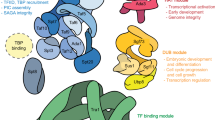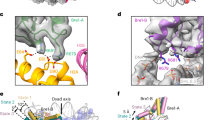Abstract
Although increasing evidence indicates that there is a direct link between ubiquitination and mono-ubiquitination and transcription in yeast, this link has not been demonstrated in higher eukaryotes. Here we show that the major histocompatibility complex (MHC) class II transactivator (CIITA), which is required for expression of genes encoding MHC class II molecules, is ubiquitinated. This ubiquitination enhanced the association of CIITA with both MHC class II transcription factors and the MHC class II promoter, resulting in an increase in transactivation function and in the expression of MHC class II mRNA. The degree of CIITA ubiquitination was controlled by histone acetylases (HATs) and deacetylases (HDACs), indicating that the crucial cellular processes mediated by these enzymes are linked to regulate transcription. Thus, ubiquitin positively regulates a mammalian coactivator by enhancing its assembly at the promoter.
This is a preview of subscription content, access via your institution
Access options
Subscribe to this journal
Receive 12 print issues and online access
$209.00 per year
only $17.42 per issue
Buy this article
- Purchase on Springer Link
- Instant access to full article PDF
Prices may be subject to local taxes which are calculated during checkout







Similar content being viewed by others
References
Hershko, A. & Ciechanover, A. The ubiquitin system. Annu. Rev. Biochem. 67, 425–479 (1998).
Chau, V. et al. A multiubiquitin chain is confined to specific lysine in a targeted short-lived protein. Science 243, 1576–1583 (1989).
Thrower, J.S., Hoffman, L., Rechsteiner, M. & Pickart, C.M. Recognition of the polyubiquitin proteolytic signal. EMBO J. 19, 94–102 (2000).
Pickart, C.M. Mechanisms underlying ubiquitination. Annu. Rev. Biochem. 70, 503–533 (2001).
Pickart, C.M. Ubiquitin enters the new millennium. Mol. Cell 8, 499–504 (2001).
Hansen, J.C., Tse, C. & Wolffe, A.P. Structure and function of the core histone N-termini: more than meets the eye. Biochemistry 37, 17637–17641 (1998).
Johnson, E.S. Ubiquitin branches out. Nat. Cell Biol. 4, E295–E298 (2002).
Sun, Z.W. & Allis, C.D. Ubiquitination of histone H2B regulates H3 methylation and gene silencing in yeast. Nature 418, 104–108 (2002).
Conaway, R.C., Brower, C.S. & Conaway, J.W. Emerging roles of ubiquitin in transcription regulation. Science 296, 1254–1258 (2002).
Ghosh, S., May, M.J. & Kopp, E.B. NF-κB and Rel proteins: evolutionarily conserved mediators of immune responses. Annu. Rev. Immunol. 16, 225–260 (1998).
Salghetti, S.E., Caudy, A.A., Chenoweth, J.G. & Tansey, W.P. Regulation of transcriptional activation domain function by ubiquitin. Science 293, 1651–1653 (2001).
Harton, J.A. & Ting, J.P. Class II transactivator: mastering the art of major histocompatibility complex expression. Mol. Cell Biol. 20, 6185–6194 (2000).
Ting, J.P. & Trowsdale, J. Genetic control of MHC class II expression. Cell 109 (suppl.), S21–S33 (2002).
Steimle, V., Otten, L.A., Zufferey, M. & Mach, B. Complementation cloning of an MHC class II transactivator mutated in hereditary MHC class II deficiency (or bare lymphocyte syndrome). Cell 75, 135–146 (1993).
Mach, B., Steimle, V., Martinez-Soria, E. & Reith, W. Regulation of MHC class II genes: lessons from a disease. Annu. Rev. Immunol. 14, 301–331 (1996).
Masternak, K. et al. CIITA is a transcriptional coactivator that is recruited to MHC class II promoters by multiple synergistic interactions with an enhanceosome complex. Genes Dev. 14, 1156–1166 (2000).
Zhu, X.S. et al. Transcriptional scaffold: CIITA interacts with NF-Y, RFX, and CREB to cause stereospecific regulation of the class II major histocompatibility complex promoter. Mol. Cell. Biol. 20, 6051–6061 (2000).
Fontes, J.D., Jiang, B. & Peterlin, B.M. The class II trans-activator CIITA interacts with the TBP-associated factor TAFII32. Nucleic Acids Res. 25, 2522–2528 (1997).
Jabrane-Ferrat, N., Nekrep, N., Tosi, G., Esserman, L. & Peterlin, B.M. MHC class II enhanceosome: how is the class II transactivator recruited to DNA-bound activators? Int. Immunol. 15, 467–475 (2003).
Terrell, J., Shih, S., Dunn, R. & Hicke, L. A function for monoubiquitination in the internalization of a G protein-coupled receptor. Mol. Cell 1, 193–202 (1998).
Robzyk, K., Recht, J. & Osley, M.A. Rad6-dependent ubiquitination of histone H2B in yeast. Science 287, 501–504 (2000).
Pham, A.D. & Sauer, F. Ubiquitin-activating/conjugating activity of TAFII250, a mediator of activation of gene expression in Drosophila. Science 289, 2357–2360 (2000).
Zika, E., Greer, S.F., Zhu, X.S. & Ting, J.P. Histone deacetylase 1/mSin3A disrupts γ-interferon-induced CIITA function and major histocompatibility complex class II enhanceosome formation. Mol. Cell. Biol. 23, 3091–3102 (2003).
Pattenden, S.G., Klose, R., Karaskov, E. & Bremner, R. Interferon-γ-induced chromatin remodeling at the CIITA locus is BRG1 dependent. EMBO J. 21, 1978–1986 (2002).
Fontes, J.D., Kanazawa, S., Nekrep, N. & Peterlin, B.M. The class II transactivator CIITA is a transcriptional integrator. Microbes Infect. 1, 863–869 (1999).
Mahanta, S.K., Scholl, T., Yang, F.C. & Strominger, J.L. Transactivation by CIITA, the type II bare lymphocyte syndrome-associated factor, requires participation of multiple regions of the TATA box binding protein. Proc. Natl. Acad. Sci. USA 94, 6324–6329 (1997).
Masternak, K. & Reith, W. Promoter-specific functions of CIITA and the MHC class II enhanceosome in transcriptional activation. EMBO J. 21, 1379–1388 (2002).
Sisk, T.J., Gourley, T., Roys, S. & Chang, C.H. MHC class II transactivator inhibits IL-4 gene transcription by competing with NF-AT to bind the coactivator CREB binding protein (CBP)/p300. J. Immunol. 165, 2511–2517 (2000).
Spilianakis, C., Papamatheakis, J. & Kretsovali, A. Acetylation by PCAF enhances CIITA nuclear accumulation and transactivation of major histocompatibility complex class II genes. Mol. Cell. Biol. 20, 8489–8498 (2000).
Zhu, X.S. & Ting, J.P. A 36-amino-acid region of CIITA is an effective inhibitor of CBP: novel mechanism of γ-interferon-mediated suppression of collagen α2I and other promoters. Mol. Cell Biol. 21, 7078–7088 (2001).
Magner, W.J. et al. Activation of MHC class I, II, and CD40 gene expression by histone deacetylase inhibitors. J. Immunol. 165, 7017–7024 (2000).
Jiang, H. et al. PCAF interacts with tax and stimulates tax transactivation in a histone acetyltransferase-independent manner. Mol. Cell. Biol. 19, 8136–8145 (1999).
Beresford, G.W. & Boss, J.M. CIITA coordinates multiple histone acetylation modifications at the HLA-DRA promoter. Nat. Immunol. 2, 652–657 (2001).
Fontes, J.D., Kanazawa, S., Jean, D. & Peterlin, B.M. Interactions between the class II transactivator and CREB binding protein increase transcription of major histocompatibility complex class II genes. Mol. Cell. Biol. 19, 941–947 (1999).
Kretsovali, A. et al. Involvement of CREB binding protein in expression of major histocompatibility complex class II genes via interaction with the class II transactivator. Mol. Cell. Biol. 18, 6777–6783 (1998).
Grossman, S.R. et al. Polyubiquitination of p53 by a ubiquitin ligase activity of p300. Science 300, 342–344 (2003).
Cressman, D.E., O'Connor, W.J., Greer, S.F., Zhu, X.S. & Ting, J.P. Mechanisms of nuclear import and export that control the subcellular localization of class II transactivator. J. Immunol. 167, 3626–3634 (2001).
Cressman, D.E., Chin, K.C., Taxman, D.J. & Ting, J.P. A defect in the nuclear translocation of CIITA causes a form of type II bare lymphocyte syndrome. Immunity 10, 163–171 (1999).
Ashburner, B.P., Westerheide, S.D. & Baldwin, A.S. Jr. The p65 (RelA) subunit of NF-κB interacts with the histone deacetylase (HDAC) corepressors HDAC1 and HDAC2 to negatively regulate gene expression. Mol. Cell. Biol. 21, 7065–7077 (2001).
Riley, J.L., Westerheide, S.D., Price, J.A., Brown, J.A. & Boss, J.M. Activation of class II MHC genes requires both the X box region and the class II transactivator (CIITA). Immunity 2, 533–543 (1995).
Lafarga, M. et al. Clastosome: a subtype of nuclear body enriched in 19S and 20S proteasomes, ubiquitin, and protein substrates of proteasome. Mol. Biol. Cell. 13, 2771–2782 (2002).
Piskurich, J.F., Linhoff, M.W., Wang, Y. & Ting, J.P. Two distinct γ-interferon-inducible promoters of the major histocompatibility complex class II transactivator gene are differentially regulated by STAT1, interferon regulatory factor 1, and transforming growth factor β. Mol. Cell. Biol. 19, 431–440 (1999).
Wong, A.W. et al. Regulation and specificity of MHC2TA promoter usage in human primary T lymphocytes and cell line. J. Immunol. 169, 3112–3119 (2002).
Osborne, A., Zhang, H., Yang, W.M., Seto, E. & Blanck, G. Histone deacetylase activity represses γ-interferon-inducible HLA-DR gene expression following the establishment of a DNase I-hypersensitive chromatin conformation. Mol. Cell. Biol. 21, 6495–6506 (2001).
Acknowledgements
We thank B. Tansey, Y. Xiong and J. McCarville for helpful discussion and B. Strahl for critically reading the manuscript. This work was supported by National Institutes of Health grants 29564, 45580, 41751 and DK38108 (to J.P.-Y.T.), and by the National Multiple Sclerosis Society (S.F.G.)
Author information
Authors and Affiliations
Corresponding author
Ethics declarations
Competing interests
The authors declare no competing financial interests.
Supplementary information
Supplementary Fig. 1.
Flag-CIITA and Myc-CIITA have comparable half-lives. Pulse-chase analysis was used to measure the stability of transfected Flag-CIITA and transfected Myc-CIITA in COS7 cells. Cells were transfected with 1 μg Flag-CIITA or 1 mg Myc-CIITA and 24 h post-transfection were labeled with 35S-methionine and immunoprecipitated with anti-Flag (lanes 1-5) or anti-Myc (lanes 6-10). Both versions of CIITA have similar, extended half-lives. Identical data were obtained with a Hemagglutinin-tagged CIITA protein (not shown). (PDF 24 kb)
Supplementary Fig. 3.
Ubiquitin enhances the association of CIITA with the endogenous MHC class II promoter. (a) Chromatin immunoprecipitation assays were performed on 293T cells stably expressing Fg-CIITA alone or in the presence of HA-ubiquitin. Chromatin immunoprecipitation was performed using anti-FLAG mAb M5 and MHC class II HLA-DRA promoter DNA was detected by quantitative real-time PCR. Real-time PCR values were determined by subtracting values obtained from bead-only immunoprecipitations. Input values demonstrate the total amount of MHC class II promoter DNA present in lysates (right top panel). As a negative control, Actb promoter DNA sequence was also assessed (right bottom panel). Input represents 1% of the total chromatin introduced into each immunoprecipitation reaction. Representative of four independent experiments. (b) Identical to (a) except mono-ubiquitin is shown. (c) The rabbit polyclonal anti-CIITA was generated against E coli derived 6xHis, FLAG tagged CIITA aa 1-333. Specificity was tested as follows: 1 x 106 COS7 were transfected with 1 μg vector containing Flag-CIITA aa 336-884 (lane 1), or HA-CIITA (lane 2). Eighteen hrs post-transfection cells were lysed in RIPA buffer and immunoblotted with anti-FLAG (panel 1), anti-CIITA (panel 2) or anti-preimmune serum (panel 3). Blots are representative of three independent experiments. (d) 1 x 106 COS7 cells were transfected with 1 μg Fg-CIITA. Eighteen hours post-transfection cells were lysed in RIPA buffer and the following samples were immunoblotted with the anti-FLAG mAb M2: total lysate (lane 1), lysate depleted of CIITA after immunoprecipitation with anti-CIITA (lane 2), anti-CIITA immunoprecipitation (lane 3) or anti-PKA control antibody immunoprecipitation (lane 4). Blot is representative of three independent experiments. (PDF 107 kb)
Rights and permissions
About this article
Cite this article
Greer, S., Zika, E., Conti, B. et al. Enhancement of CIITA transcriptional function by ubiquitin. Nat Immunol 4, 1074–1082 (2003). https://doi.org/10.1038/ni985
Received:
Accepted:
Published:
Issue Date:
DOI: https://doi.org/10.1038/ni985
This article is cited by
-
Protein arginine methyltransferase 1 (PRMT1) represses MHC II transcription in macrophages by methylating CIITA
Scientific Reports (2017)
-
Development of potent class II transactivator gene delivery systems capable of inducing de novo MHC II expression in human cells, in vitro and ex vivo
Gene Therapy (2017)
-
The Cul4A–DDB1 E3 ubiquitin ligase complex represses p73 transcriptional activity
Oncogene (2013)
-
Role of the ubiquitin–proteasome system in nervous system function and disease: using C. elegans as a dissecting tool
Cellular and Molecular Life Sciences (2012)
-
Towards a systems understanding of MHC class I and MHC class II antigen presentation
Nature Reviews Immunology (2011)



